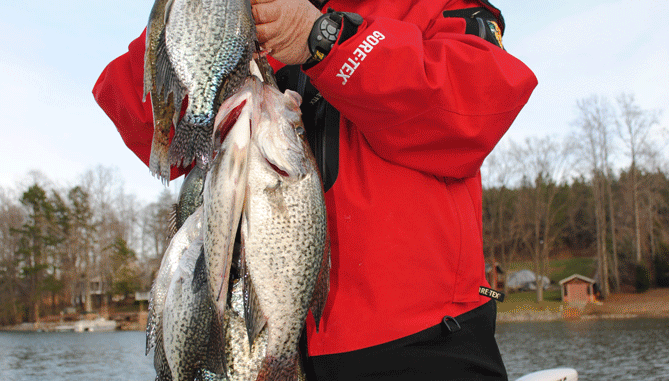
March is prime time to sample a rebounding crappie fishery on this Catawba River impoundment.
With the exception of perhaps striped bass, there appears to be a great awakening at Lake Norman, formerly referred to by scores of anglers as North Carolina’s “Great Dead Sea.”
An excellent fishery for blue catfish has developed over the past half-dozen years. Spotted bass are all over the lake, providing bass fishermen with a second target in addition to largemouths. White perch have shown up from who knows where in great numbers.
Oh, and for the first time in years, crappie fishermen can actually expect to catch a mess of fish from the 32,500-acre reservoir on the Catawba River north of Charlotte.
“Five or six years ago, you could catch crappie at Lake Norman, but not many — a good day might be about 15, but they’d be real slabs,” said Jerry Neeley of Carolinas Fishing Guide Service. “Now, a good day is 100 fish, and a fair day is 50 to 55. And it’s not unusual to catch 2½-pound crappie at Norman. Last year, I caught seven or eight over two pounds one day at the end of March when they were so shallow you could see them up against the bank in the back of coves.”
Neeley said the uptick in crappie fishing started at about the same time that striper fishermen brought in alewifes, a non-native baitfish, and did a little “bait-bucket stocking” in Norman to try and improve the striper fishery.
“I thought what happened was, when they put all that bait in there, it meant more forage in the lake for crappie and other species,” he said. “I think it’s been a great benefit for them.”
But Neeley’s guiding partner, Chris Nichols, points to another facet that Neeley also mentioned: a rise in Norman’s overall fertility. It shows up in the amount of forage fish other than alewifes, especially threadfin shad — a crappie’s No. 1 meal.
“The water stays a little dirtier now than it used to be; I think the lake is more fertile,” Nichols said. “There is a lot more development around the lake, and more people are fertilizing their lawns, and that runs off and puts more nutrients in the lake for the food chain.
“The shad population has gotten to be pretty strong in Norman. As a general rule, you can see a lot more baitfish than you did 10 years ago. It’s not uncommon to see bait on your (depthfinder) all the time — not like you do at Lake Wylie or Lake Wateree, but you see a lot more bait.”
Whatever the reason, Norman is a lot better crappie fishery than it was just a few years ago, and the first really good month of the year is March, when slabs begin to stir and had back in the creeks toward the shoreline where they will conduct their spring spawn.
“At the end of February, I start watching my temperature gauge,” Neeley said. “The water temperature won’t start to go up until the nights stay warm. When the temperature stays in the 40s at night, then the water will start to arm up. Typically, that’s around the end of February. The days are getting longer and we usually get three or four warm days in a row.
“When the water temperature gets to 50, they’ll start to move out of the main lake and into the creeks, and they’ll stay there until after they spawn. It might be the end of May or the first of June before they’ll get back out of the creeks.”
As the water warms through the low- to mid-50s, Neeley said you can follow crappie back into creeks toward the coves where they’ll eventually spawn. The best fishing will arrive when the water temperature is in the 59- to 65-degree range, when fish will be spawning.
When they get to the bank, Neeley said it’s a matter of going down the bank with a minnow or mini-jig a foot under a cork, “stopping and popping” the bait down in front of every little piece of visible cover that might be holding a fish.
“Last year, I caught seven or eight fish over two pounds the same day at the end of March when the water was 60 degrees and they were so shallow you could see them in the back of the coves.”
But the fishermen who waits for the spawn to arrive misses most of March’s great action, which takes place a good ways off the bank.
Neeley and Nichols focus on the lower end of the lake, which has had the reputation of being less fertile and less “productive” than the upper end, above the NC 150 bridge, but only because it’s more convenient to their homes in Gaston County.
“You can do what we do all over the lake and catch fish,” Nichols said. “The few times we’ve fished up the lake, we’ve caught plenty of crappie. We just fish the lower end because it’s more convenient to us, and because of the price of gasoline. But the whole lake is just as productive.”
One thing that makes an area productive for crappie, Nichols said, is cover where crappie can stop and stage while they’re making their way back in the creeks. That largely means boat docks and piers, because that’s the main form of visible cover on the lake, but not all boat docks are created equal.
“The first thing you have to have is deep water at the end of the pier,” he said. “The minimum for crappie at Lake Norman is eight to 10 feet, but I look for piers with 10 to 15 feet of water at the end, and that stair-steps up the bank. As the fish move up, they’ll move from the end of the pier to the middle.
“The second thing would be shade. You’ll catch a few fish in the sun out around the edge of the pier, but the vast majority will be back up under the pier in the shade. A boat that’s tied up to a pier or in a slip provides shad.
“Third, it helps to have some structure around the pier. It can be pier pilings, any of the wood around the pier, or it can be man-made brushpiles.”
Ah, brushpiles. According to Neeley, they’re not as common on Norman as they are on other lakes up and down the Yadkin or Catawba systems, where crappie-fishing is something akin to a religious experience during the spring. So when you find brushpiles around or under a pier, that’s like drawing an inside straight in poker.
“I put in 40 brushpiles over the last 30 days,” Nichols admitted. I put most of them in close proximity to piers. I like to put them around piers where crappie make their last stop before they go to the banks to spawn.”
Neeley said that brushpiles he’s found or put in – along with Nichols’ brushpiles – he can jump from pier to pier and brushpile to brushpile, catching a few crappie at each stop; he calls it his “sugar run.
“If you’ve got a depthfinder on your boat, you can go find brush around piers,” he said. “You just move along about two or three miles per hour until you find brushpiles, then you mark hem on your map or your GPS. Just about all the brushpiles will be around docks, especially in Mountain Creek and Little Creek. There are some people who put brush out around docks.
“The other thing you can look for is lights on the piers that are close to the water and rod-holders. Those are dead giveaways. If you see a sink on a pier that’s there as a fish-cleaning station, you know dog-gone well they’ve got some brush around that pier.
Neeley said he starts in early March looking for places where crappie will stop as they move into a creek. He’ll find the first secondary point back in the creek and fish the two docks closest to the point on either side. “One of those docks will be holding crappie,” he said. “When they’re getting ready to spawn, they stop there going back in. You need to fish the biggest and widest parts of the dock and the parts with brush. And they’ll get stronger and stronger on those piers before they move farther back in the creek.”
Neeley said that he catches more black crappie than white crappie on Lake Norman, but that whites seem to be more prevalent in Mountain Creek, a major tributary on the lake’s western shoreline.
“The white crappie are usually bigger, and if you find them, usually you’ll catch all of them,” he said. “If you get in a school of black crappie, you’ll catch five or 10, and they’ll quit biting. You get in a school of 20 white crappie and you’ll catch 15 of them.”
DESTINATION INFORMATION
WHEN TO GO/HOW TO GET THERE — Lake Norman is a Catawba River impoundment that covers 32,500 acres and stretches from the northwestern outskirts of Charlotte to I-40 west of Statesville. Public boat access areas dot the lake’s shoreline, especially the eastern bank, most of which is close to I-77. The Pinnacle and McCrary Creek ramps are on either side of NC 150 just ease of the lake at mid-lake. Access areas at Ramsey Creek, Beatties Ford and Blythe Landing access the lower end near Cowan’s Ford Dam. Mountain Creek, Hagar Creek and Little Creek are popular spots for crappie fishermen. Prime crappie fishing begins around the first of March and can last into mid-April.
TACKLE/TECHNIQUES —Light-action spinning and spincasting tackle, light line and mini-jigs from 1/16th- to 1/32nd-ounces are the ticket to skip baits back under docks and around neighboring brushpiles. For fish spawning along the bank, a mini-jig or live minnow fished 12 to 14 inches below a cork is the norm.
FISHING INFO/GUIDES — Jerry Neeley/Chris Nichols, Jerry’s Fishing Guide Service, 704-678 1043 or 704-868-2298, http://www.carolinasfishing.com/; Byrum’s General Store, Charlotte, 704-588-0434. .See also GUIDES & CHARTERS in Classifieds.
ACCOMMODATIONS — Lake Norman Convention and Visitors Bureau, 704-987-3300, http://www.visitlakenorman.org/.
MAPS — Duke Energy, www.duke-energy.com/lakes/facts-and-maps/lake-norman.asp; Kingfisher Maps, 800-326-0257 Ext 1,http://www.kfmaps.com/.

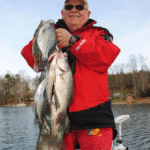
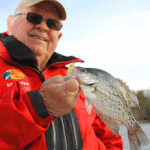
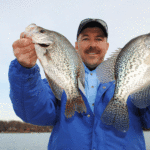
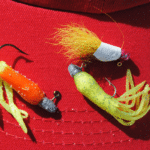




Be the first to comment